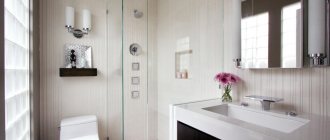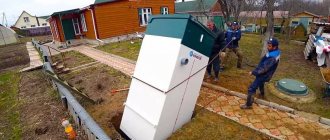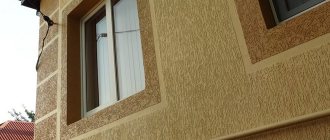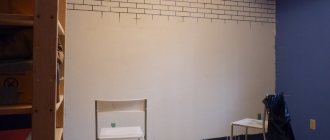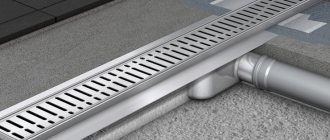A summer resident who decides to start developing his plot inevitably faces a lot of issues that definitely need to be resolved. One of these issues is the construction of a latrine, without which a comfortable stay at the dacha is simply impossible.
Biotoilets using peat are becoming increasingly popular among summer residents, which not only do not require connection to a sewer system, but also transform waste from the human body into a very convenient organic fertilizer.
Compost toilet
Another undeniable advantage of a composting toilet is that there is no need to flush waste with large amounts of water. By the way, it does not require water at all, because all functions are performed by special peat mixed with sawdust and active bacteria.
Of course, you can purchase such a miracle of modern technology by purchasing it in a store or ordering it online, but this pleasure significantly impacts the family budget. Fortunately, such a device as a peat dry closet has a fairly simple design, so you can try to build it yourself. How? We will talk about this in the article.
Classic design
A do-it-yourself composting toilet is usually built not just outside the living space, but also in compliance with sanitary requirements , relating, first of all, to minimum distances to certain objects (for example, there should be 25-50 meters to a source of drinking water, if we are not talking about completely sealed storage tank or design adapted for indoor installation).
Composting toilets for a summer residence are a container (tanks, barrels, and even something like a cesspool with sealed walls can be used in this capacity), equipped with a toilet seat and a lid. Usually they are installed in a separate booth, called a “birdhouse” or “hut” depending on the design.
For convenience, the top of the container is covered with a plywood or plank box. Disposal of waste and its transportation to a compost pit can be carried out in various ways. For example, through a special door. Fairly believing that cleaning a compost bin, although rarely required, is not the most pleasant task, many choose special large bins on wheels. Using them, there is no need to shovel or carry heavy containers. The tank is transported to the pit and quickly emptied.
Diagram of a standard peat toilet (powder closet) with a remote container
Note: An important element of a compost toilet in a country house is ventilation. Air flow is necessary for the normal functioning of bacteria that convert waste into compost.
In large-volume compost toilets (more than 50 liters), dry peat can and should be replaced with a mixture of peat and sawdust. This composition promotes aeration, and therefore increases the intensity of the process.
How to make drainage?
Do-it-yourself drainage for a dry closet
In order to absorb all the liquid that gets into the receiving container, you need to pour a decent amount of peat into it, and the more people use this toilet, the more filler you will have to use.
The liquid from the tank will be partially absorbed by the peat, partially evaporated, but everything else will need to be removed through drainage.
The design of the drainage system is extremely simple. For it you will need:
- Two containers, one of which fits tightly into the other;
- Hose.
Holes are made in the bottom of the inner container, after which it is inserted into the outer one, in the side of which a hole has already been made. A hose is connected to the side hole of the outer container, draining the liquid into a drain or into a small homemade collector.
Bucket toilet
Peat composting toilets for the garden made from buckets are a convenient option that requires a minimum of effort to manufacture. In fact, to obtain the finished structure, it is enough to connect a bucket and a toilet seat with a lid.
The undoubted advantage of such a structure is its compactness and mobility . It can be installed in a shed, outdoor birdhouse, or brought indoors at night or during rainy weather. In addition, there is no need to comply with any requirements regarding distances between objects - no harmful substances can penetrate the soil from such a bucket.
Homemade toilet on a bucket
The process of using a structure can be optimized in various ways.
- You can increase the hygiene of the structure and simplify the cleaning process by using dense and durable garbage bags that can withstand quite a lot of weight.
- If the peat toilet model for a summer house is used inside the house, and the absence of an unpleasant odor is more important than the actual production of compost, peat for backfilling waste can be replaced with cat litter.
- It is more convenient to dispose and transport waste if, instead of one bucket, two different diameters are used, inserted into one another.
- In order not to spend even minimal effort to create a country peat dry closet on a bucket, you can buy a ready-made product - cheap, convenient, roomy and strong enough to withstand a lot of weight.
Advantages and disadvantages
This type of toilet has a number of advantages:
- He has mobility. Since there is no need to use sewerage or water drainage, such a toilet can be installed in almost any necessary place.
- Cheap to install and use. Packages of peat for dressing are available for sale. For a small family, one such package can be enough for a year.
- During operation, no unpleasant odor is formed. This is due to the deodorizing ability of peat.
- It is possible to use such a toilet not only for a summer residence, but also in many cases where its mobility is important. One example would be a situation where a home is being renovated and the sewer system is temporarily turned off. In this case, a peat toilet may be one way to solve the problem.
- The consumable material (peat) does not harm the environment.
Peat is a natural material that can subsequently be used to fertilize the garden. Source agbz.ru
Processing waste to form compost, which can then be used as fertilizer.
However, they have some disadvantages:
- When using the toilet, it is necessary to ensure ventilation and drainage of liquid.
- Problems may arise when operating during the winter. For example, peat can freeze at low temperatures.
- A peat toilet is a fairly mobile option, but a portable dry toilet has even more compact dimensions.
A portable dry toilet is a more mobile option that you can take with you on the road. Source rosanneglass.co
The main factors affecting the operation of a peat toilet
Since the process of compost formation occurs due to the activity of bacteria, its course is influenced by certain biological factors.
- The presence of oxygen is ensured by ventilation. It also removes unpleasant odors. It is also worth noting that the intensity of the odor is much lower if an optimal mode of the composting process is created.
- The moisture contained in excrement and urine is excessive, so additional liquid should not be allowed into the composting toilet. Excess moisture can be reduced in various ways:
- ventilation,
— arrangement of evaporation chambers (applicable for large containers),
— separation of flows (some purchased eco-toilets for summer cottages have a separate discharge of the liquid component, leaving only solid waste for compost formation),
- using fillers (in addition to peat, sawdust, shavings, coconut fiber, ash, lime mixed with soil, etc. are used in this capacity).
- High temperature helps reduce the decomposition time of waste, so purchased designs often have a thermometer for monitoring. They are also often used to equip large continuous composting toilets, the operation of which is difficult to control due to the large volume of the storage tank.
Closets without a cesspool: the main types and their features
A drainage pit is considered the simplest and most cost-effective way to solve the problem with a toilet in a personal plot. Even so, there are limitations to this type of design. The installation of pit latrines is limited to the following conditions:
- the soil of the summer cottage consists of limestone or shale soil;
- groundwater passes too close to the surface;
- the toilet is expected to be used by a large number of people.
All these factors do not allow organizing a toilet based on a cesspool on the territory of a suburban area. The way out of this situation will be the construction of latrines of a completely different type, based on a different principle of operation.
Classification of composting toilets
These convenient devices can be classified depending on the characteristics of the work.
- Active models differ from passive ones in the presence of equipment for regulating the operating mode - thermostats, fans, heaters, etc. In active products, compost formation usually occurs throughout the year. In passive ones, the duration of the period depends on external factors, primarily on temperature, and can be about two years or more.
- Self-contained products are closed units, while designs with a remote composting unit can consist of several receptacles with toilet seats and one composting tank located at a certain distance.
- Bagged composting peat toilets are completely emptied after the chamber is filled. Continuous designs allow the finished compost to be recovered and used while the reservoir continues to be filled and waste converted. This operating principle can only be implemented for stationary models with large-volume storage devices.
Construction of a toilet for a summer house: drawing with dimensions for a “birdhouse” type structure
The design of the Birdhouse consists of wood, which can be covered with any other type of material. Construction of a single or gable roof is allowed. This type of closet is mounted as an above-ground building above the cesspool.
Typical design of a “Birdhouse” with dimensional parameters:
| Design element | Size, m |
| Rear wall (height) | 2 |
| Width | 1 |
| Front wall (height) | 2,3 |
| Base area | 1x1 |
When installing a wooden toilet structure, mandatory control of the placement of surfaces vertically and horizontally is necessary. For these purposes, it is recommended to use a building level.
Continuous Composting Toilet
If installing a peat toilet in a dacha with your own hands outside a living space is quite appropriate, then “conveniences in the yard” for permanent residence create certain difficulties, especially in the cold season.
One of the advantages of a continuous peat dry closet is the ability to install it in your home. However, the toilet seat itself is located in a heated room, and the storage unit can be installed in the basement or outdoors. In the second case, it will work slower if it is not equipped with heating elements.
The photo shows a diagram of a peat composting toilet
When organizing a compost toilet at your dacha with your own hands, the storage tank is used as a reservoir with an inclined bottom (about 25-30 degrees) for spontaneous movement of a mass of waste. The size of the structure can be about 2-3 meters in length and 1-2 meters in width. With the help of such a peat former you can also dispose of kitchen waste. It is optimal if the discharge hatch is located next to the toilet.
Before you make a peat dry closet for your dacha with your own hands, you need to know that when building such a structure yourself, it is important to pay due attention to the strength of all surfaces (floor, walls, ceiling) and the presence of a reliable sealing, moisture-proof layer.
The floor is usually made of concrete, and the walls are made of brick, using reinforcing elements during pouring or during laying for greater reliability. After the solution has hardened, all surfaces are covered with an insulating layer , which can be special ready-made primers and mastics or homemade compositions (for example, based on bitumen).
Due to the large volume of the tank and the large amount of processed waste, point ventilation input will not be enough for high-quality aeration. To ensure a uniform supply of air, a collector is arranged, to which pipes with holes are welded in a checkerboard pattern. If the ventilation manifold is made of metal, it must be covered with a waterproofing solution, just like the walls.
A vertical partition made of waterproofed sheet metal is installed inside the chamber between the entrances from the toilet and the food waste chute . It does not reach the bottom of the tank, so as not to interfere with the movement of the mass of waste along an inclined plane, but it prevents the penetration of unpleasant odors into the kitchen.
A continuous composting peat toilet is more complex to set up, but much more convenient
For convenience, the end wall of the lower part of the storage tank is often stepped and equipped with two hatches - for raking out the finished compost and for adding peat or peat-sawdust mass. Obviously, the first hatch is located below the second. When part of the finished compost is removed, the entire mass moves along the inclined bottom, filling the vacant space. This ensures continuous operation of the peat toilet for the dacha. Before commissioning, the floor of such structures is covered with a layer of peat or a mixture of peat and sawdust about 10 centimeters high.
How to build a toilet in a country house without smell and pumping, that is, without a cesspool, is described in our separate article.
Options for toilets for country closets are described here.
We advise you to draw your attention to the material in which you will find information on choosing washbasins https://okanalizacii.ru/postrojki/umyvalnik/umyvalnik-dachnyj-s-podogrevom-vody.html
Backlash closet
A backlash closet is a type of toilet connected to a sealed cesspool. The waste tank is located behind the foundation, to which it is connected directly or through an inclined pipe. It is equipped with a hatch through which it is convenient to clear waste. The bottom of the container is tilted towards the lid so that waste accumulates next to it
Unlike a traditional house with a cesspool, a backlash closet can be installed inside the house. This eliminates the need to additionally insulate the structure. This type of toilet is suitable for permanent use in houses without a sewer connection and is built without the possibility of further movement.
Ready-made models
On sale you can find ready-made composting toilets of various sizes and modifications - from portable to large continuous chambers built into the basement. As a rule, the most advanced of them are equipped with control devices and equipment to create an optimal mode.
Small compact dry closets of this type may have special tanks for dry peat. The composition is automatically scattered evenly over the surface when you turn the handle. Stationary models can be equipped with a membrane built into the bottom and a pipeline to drain the liquid component of the waste.
The most popular brands of peat composting toilets include Piteco, BioComfort, Compact, Biolan, Ekomatik (Ekomatik).
Minuses
- If the storage tank is overfilled, removing it can cause some problems due to the fact that it becomes heavier. This problem is solved by choosing a model whose lower tank is equipped with wheels for transportation.
- The need for additional work to organize outlet openings for ventilation and the outlet pipe itself. Although, this problem can be solved by choosing a model with a drainage system.
- When sprinkling waste, it is possible that a layer of peat is laid unevenly on it, as a result of which it is necessary to carry out an additional step to level the bedding using a scoop.
Drainage system design
The collection barrel must be used with the top lid open (cut off). Place a geotextile bag inside it, and then fill it with a mixture of sand and fine granite crushed stone, vermiculite, expanded clay - any incompressible material with high hygroscopicity. You need to fill it to such a level that the installed storage capacity is 150-200 mm below the neck of the barrel.
Containers must be prepared in advance. In the lower half of the walls of the external collector we make 10 mm holes every 7-10 mm in a total quantity of 20-25 pieces, and we carry out the same manipulations with the bottom.
We measure the dimensions of the side at the top of the container and bend a sheet of 1.2 mm galvanized iron along this profile, forming a rectangular casing about 150 mm high. In its lower part, we cut the ribs by 10-15 mm, bend each one inward, forming a side around the perimeter on which the inner container can rest. We fasten the casing with rivets, and use them to fix it to the plastic side of the external storage tank so that the edges of the bent metal do not reduce the gap between the plastic sides.
We install the container with the casing, leveling the top 2-3 cm below the closed lid of the barrel. We move it closer to the front edge, approximately 50-70 mm from the wall. We sprinkle the receiver on all sides with sand so that the side of the casing protrudes by 30-50 mm, and the layer of sand from the surface to the first holes in the drive is at least 30 cm. Lightly compact and spill the sand with a small amount of water. The second container can be inserted into the first without any effort, and the following can be placed inside:
- replaceable geotextile bags that will be changed each time the storage tank is emptied;
- case made of stainless steel mesh with a mesh size of 0.4-0.75, which can be easily washed with water from a hose.
This element is optional, but it makes waste disposal very easy, especially in an emergency. If you think this is overkill, remember that the inner container with the “basket” is drilled like the outer one - with rare large holes up to the middle of the height. In the absence of a primary filter, these holes are more frequent and have a diameter of no more than 1.5-2 mm.
Drainage system design
The collection barrel must be used with the top lid open (cut off). Place a geotextile bag inside it, and then fill it with a mixture of sand and fine granite crushed stone, vermiculite, expanded clay - any incompressible material with high hygroscopicity. You need to fill it to such a level that the installed storage capacity is 150-200 mm below the neck of the barrel.
Containers must be prepared in advance. In the lower half of the walls of the external collector we make 10 mm holes every 7-10 mm in a total quantity of 20-25 pieces, and we carry out the same manipulations with the bottom.
We measure the dimensions of the side at the top of the container and bend a sheet of 1.2 mm galvanized iron along this profile, forming a rectangular casing about 150 mm high. In its lower part, we cut the ribs by 10-15 mm, bend each one inward, forming a side around the perimeter on which the inner container can rest. We fasten the casing with rivets, and use them to fix it to the plastic side of the external storage tank so that the edges of the bent metal do not reduce the gap between the plastic sides.
We install the container with the casing, leveling the top 2-3 cm below the closed lid of the barrel. We move it closer to the front edge, approximately 50-70 mm from the wall. We sprinkle the receiver on all sides with sand so that the side of the casing protrudes by 30-50 mm, and the layer of sand from the surface to the first holes in the drive is at least 30 cm. Lightly compact and spill the sand with a small amount of water. The second container can be inserted into the first without any effort, and the following can be placed inside:
- replaceable geotextile bags that will be changed each time the storage tank is emptied;
- case made of stainless steel mesh with a mesh size of 0.4-0.75, which can be easily washed with water from a hose.
This element is optional, but it makes waste disposal very easy, especially in an emergency. If you think this is overkill, remember that the inner container with the “basket” is drilled like the outer one - with rare large holes up to the middle of the height. In the absence of a primary filter, these holes are more frequent and have a diameter of no more than 1.5-2 mm.
Project of a country toilet and shower under one roof
A toilet is good, but a toilet with a shower is even better. Both of these buildings create the comfort necessary in a dacha setting. By combining these designs you can save a little on material. Let's consider the project of a country toilet with a shower and its execution.
The toilet and shower have a common wall: this will help save on building materials
The proposed diagram shows that the toilet and shower have a common wall. This is the saving of building materials. This project is designed for the installation of a dry closet.
If a cesspool is used, the design is slightly modified.
To build such a structure, they first dig a foundation pit and strengthen its walls, and only then begin the construction of the building itself
Preparing the foundation for construction
First of all, a square pit with a side of 4 meters and 0.3 cm in depth is dug for the construction and covered with gravel to about 0.2 m.
After thoroughly compacting the base, formwork from wooden panels is knocked down for a foundation 0.3 m wide and 0.5 m high.
To make the foundation more durable, it is necessary to reinforce it
A sand-cement mortar is prepared and poured into the formwork.
Crushed stone is used as filler. When the concrete has set, remove the boards and cover the defects with mortar.
After removing the formwork, defective areas are sealed with mortar.
At the next stage, sewer pipes are installed.
DIY outdoor toilet made of corrugated sheets and wood
Even at the dacha you cannot deny yourself comfort. This is especially true for the toilet
This is the most important room for creating convenience in the country. You need to worry about its arrangement even before the start of the gardening season.
Most often, far from the city there is no local sewerage system. Therefore, we have to be as sophisticated as we can.
There is a large selection of materials from which you can build a toilet.
And there are enough varieties of such buildings to choose a suitable design. Having decided on the material from which the structure will be constructed, you need to draw up a drawing of the country toilet. Thanks to it, you can calculate the amount of building materials needed. So before you start construction, draw up a work plan.
Is it possible to leave a dry closet at the dacha for the winter and how to use it correctly?
There are several important requirements that should be taken into account when servicing a dry closet in winter:
- Always check the maximum permissible negative temperatures for a specific device. One country dry toilet can only be installed indoors, while the other can be used outdoors.
- Don't forget to add antifreeze. It is worth buying only specially approved compounds, such as propylene glycol. Many antifreezes are also odor eliminators. Please read the instructions carefully before use. It is necessary to strictly observe the dosage and not exceed the volume.
- When installing the device outdoors, make sure to equip a special cabin. It is insulated from the inside, so the temperature there can differ significantly from the environment. More expensive models are equipped with heating, but this requires electricity. There are varieties that can only be used in frost-free areas.
- If you do not use the dry closet in the winter, it needs to be mothballed. Liquids, waste and other contents are pumped out, internal disinfection, and drying are carried out. The device must be stored in a frost-free room to prevent the plastic from cracking.
Empty the waste container regularly and do not pour strong chemicals or throw solid objects into it. It is better to immediately create a cleaning schedule and follow it.
The best dry closets for a summer residence may well become an alternative to the traditional sewer system, not only in summer, but also in winter. Their installation saves time and is cheaper. The simplest models start at a price of 13-15 thousand rubles, but more expensive and technologically advanced ones are also available. All you need to do is make a responsible choice.
You may also be interested in our class=”aligncenter” width=”1280″ height=”960″ Process water delivery
Hydrodynamic sewer cleaning
Mobile steam generator
Reviews
According to many consumers, for seasonal use in a country holiday setting, it is advisable to purchase the simplest and most mobile models that have a minimum set of functions, which allows you to avoid spending money on water supply and sewerage, as well as connecting electricity.
When living year-round in a private household, it is advisable to give preference to more modern, stationary structures that are resistant to temperature changes, do not require frequent emptying of the tank, and are also equipped with a system for saving peat filler.

